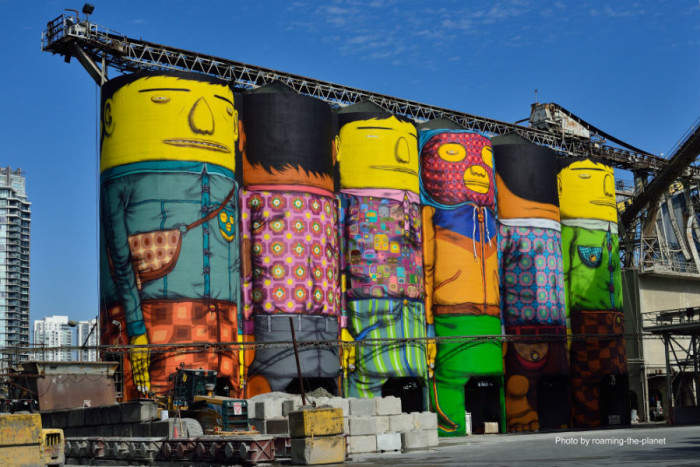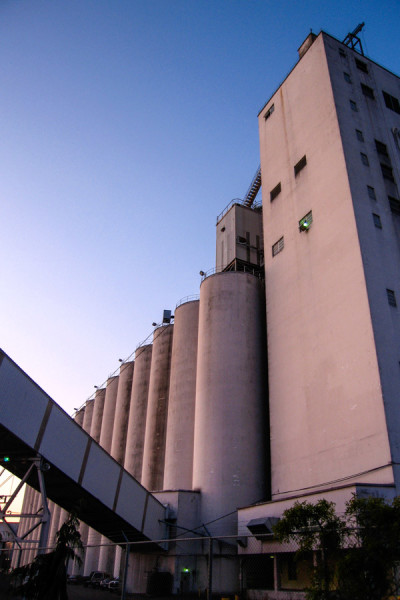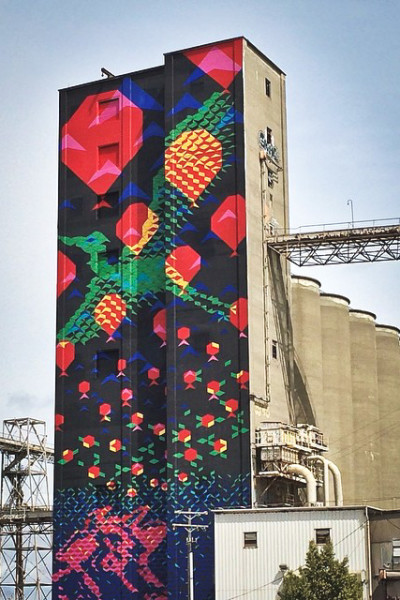
Six giants stand tall as their flat, stretched-out faces stare out across Granville Island in Vancouver. Their bright clothing adds some much-needed color to the surrounding grayness — but it also hides a secret: the fact that their bodies are industrial silos.
These beings came to life when artists Gustavo and Otavio Pandolfo painted a 23,500 square-foot mural on the six cement silos in 2014.
Seattle may soon get it’s own giant waterfront mural. A group of locals is hoping to cover the Terminal 86 Grain Facility at the base of Queen Anne Hill with public art.
A feasibility study released by the Friends of Art on Pier 86 committee on January 19 came to the conclusion that such a public art piece is possible. The 68 silos at the facility measure 130 feet high and 28 feet in diameter each.
“To me, it looks like a big, broad canvas,” said Jeff Hawk, a committee member of the Friends of Art on Pier 86. “We’re looking to improve, to beautify the environment of that structural installation on the Seattle waterfront.”

Much of the committee’s inspirations for this project were drawn from other cities that turned their silos into public art pieces. A collaboration between Australia’s largest grain exporter CBH and cultural organization FORM gave rise to silos covered with rich colors as well as black and white paints.
In San Francisco, Seattle artists Laura Haddad and Tom Drugan adorned a set of 197-foot silos with bright colors and geometrical shapes, transforming it into the “Bayview Rise” art piece in 2014. Different aspects of the art serve as an homage to local landmarks and the struggles the surrounding neighborhood experienced in recent decades.
And of course there is the “Giants” mural, an exhibit of the Vancouver Biennale, a non-profit organization dedicated to making public art accessible to surrounding communities. This exhibit has turned into an iconic art piece in Vancouver, said Ammar Mahimwalla, program manager of the Vancouver Biennale.
“It’s a part of the local landscape,” said Mahimwalla. “It’s really the place everyone wants to go.”
Hawk is hoping the Pier 86 art will have a similar effect in Seattle. “I would love for [people] to see something interesting and smile worthy when they look across to the skyline.”
This silos are leased from the Port of Seattle by the Louis Dreyfus Corporation — a huge Amsterdam-based energy and agricultural conglomerate that oddly enough was founded by the great-great grandfather of Seinfeld actress Julia Louis-Dreyfus.
According to the feasibility study, more than 60 percent of the local community supports having public art on the silos. But the specific type and medium of art that will adorn the Pier 86 silos remains to be seen. Anything from paint to video loops to banners is possible.
“[Other cities are] certainly inspiration as far as what could be done, not necessarily that we’ll do it here,” said Betty Winfield, the chair of Friends of Art on Pier 86. “Whatever happens here should be unique to here.”
The committee’s recommended theme for the art is “Celebrate Seattle’s Waterfront Heritage,” but the rest of the details of the project are still to be determined. The feasibility study is only the first step in a three-step process. Community input and art selection will be the focus of phases two and three.

This means the silos are essentially a blank canvas. Art could end up covering all four sides of the silos or only just one. A piece inspired by Seattle’s international connections could cover the north face while the side near the water celebrates waterfront activities, says Winfield. Or the final piece could turn out to be something else entirely.
The expectation is for this art piece to become an integral part of Seattle, similar to the silos in places like Granville Island and Northam.
“I think of it as a major icon for the city, something that we can all be proud of,” said Winfield.
While nothing is certain yet, Winfield hopes this possibility will turn into a celebration of a dynamic Seattle.
“Seattle today is not Seattle in 1970 when those silos and grain elevator were finished,” said Winfield. “Today, the whole focus is multiuse — it’s tourism, it’s recreation, it’s industry. We should celebrate this. And the art will help us celebrate it.”


Such a cool idea! I hope it comes to fruition. Seattle is so gray, particularly during cloudy weather, i.e. 9 months a year, and most of the houses and buildings are painted drab, neutral or dark colors. The city can really use some colorful and vibrant public art!